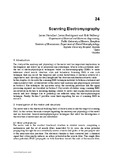Mostrar el registro sencillo del ítem
Scanning electromyography
| dc.creator | Navallas Irujo, Javier | es_ES |
| dc.creator | Rodríguez Falces, Javier | es_ES |
| dc.creator | Stålberg, Erik | es_ES |
| dc.date.accessioned | 2019-10-23T11:49:46Z | |
| dc.date.available | 2019-10-23T11:49:46Z | |
| dc.date.issued | 2012 | |
| dc.identifier.uri | https://hdl.handle.net/2454/35291 | |
| dc.description.abstract | The study of the anatomy and physiology of the motor unit has important implications in the diagnosis and follow-up of neuromuscular pathologies. Muscle action potentials allow the use of electrophysiological techniques based on electromyography (EMG) to make inferences about muscle structure, state and behaviour. Scanning EMG is one such technique that can record the temporal and spatial distribution of electrical activity of a single motor unit, allowing for deep insight into the structure and function of motor units. In this chapter, we describe the scanning EMG technique in detail, both from a technical and clinical point of view. A brief review of the motor unit anatomy and physiology is provided in Section 2. The technique, the apparatus setup, the recording procedure and the signal processing required are described in Section 3. Key results of studies using scanning EMG are reviewed in Section 4, including findings related to motor unit organisation in normal muscle and how changes due to pathology are reflected using this electrophysiological technique. Finally, Section 5 provides some hints regarding the use of scanning EMG in research. | en |
| dc.description.sponsorship | This work was supported by the Regional Health Ministry of the Government of Navarre under the project 1312/2010. | en |
| dc.format.extent | 22 p. | |
| dc.format.mimetype | application/pdf | en |
| dc.language.iso | eng | en |
| dc.publisher | InTechOpen | en |
| dc.relation.ispartof | EMG methods for evaluating muscle and nerve function, Mr. Mark Schwartz (Ed.). InTech, 2012. ISBN: 978-953-307-793-2 | en |
| dc.rights | © 2012 The Author(s). Licensee IntechOpen. This chapter is distributed under the terms of the Creative Commons Attribution 3.0 License, which permits unrestricted use, distribution, and reproduction in any medium, provided the original work is properly cited. | en |
| dc.rights.uri | http://creativecommons.org/licenses/by/3.0/ | |
| dc.subject | Scanning electromyography | en |
| dc.subject | Motor unit | en |
| dc.title | Scanning electromyography | en |
| dc.type | info:eu-repo/semantics/bookPart | en |
| dc.type | Capítulo de libro / Liburuen kapitulua | es |
| dc.contributor.department | Ingeniería Eléctrica y Electrónica | es_ES |
| dc.contributor.department | Ingeniaritza Elektrikoa eta Elektronikoa | eu |
| dc.rights.accessRights | info:eu-repo/semantics/openAccess | en |
| dc.rights.accessRights | Acceso abierto / Sarbide irekia | es |
| dc.identifier.doi | 10.5772/25975 | |
| dc.relation.publisherversion | https://doi.org/10.5772/25975 | |
| dc.type.version | info:eu-repo/semantics/publishedVersion | en |
| dc.type.version | Versión publicada / Argitaratu den bertsioa | es |
| dc.contributor.funder | Gobierno de Navarra / Nafarroako Gobernua, 1312/2010 | es |



